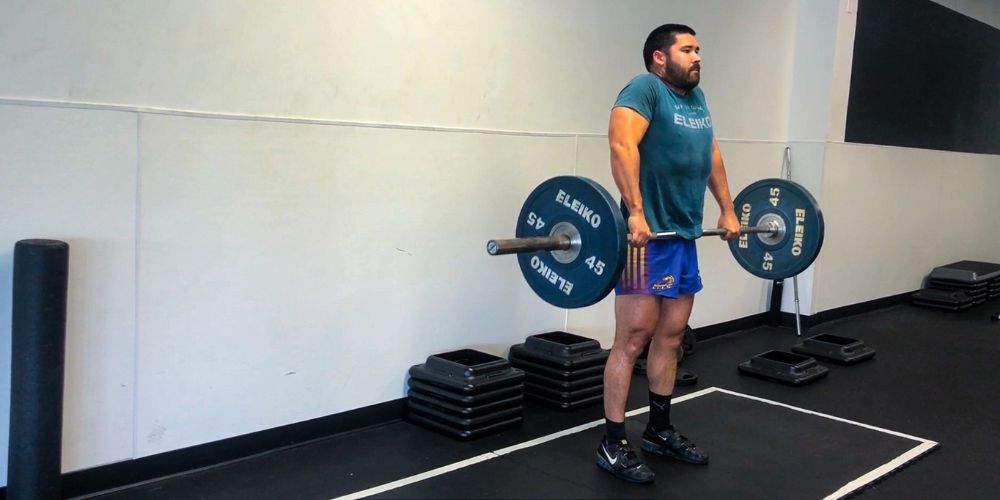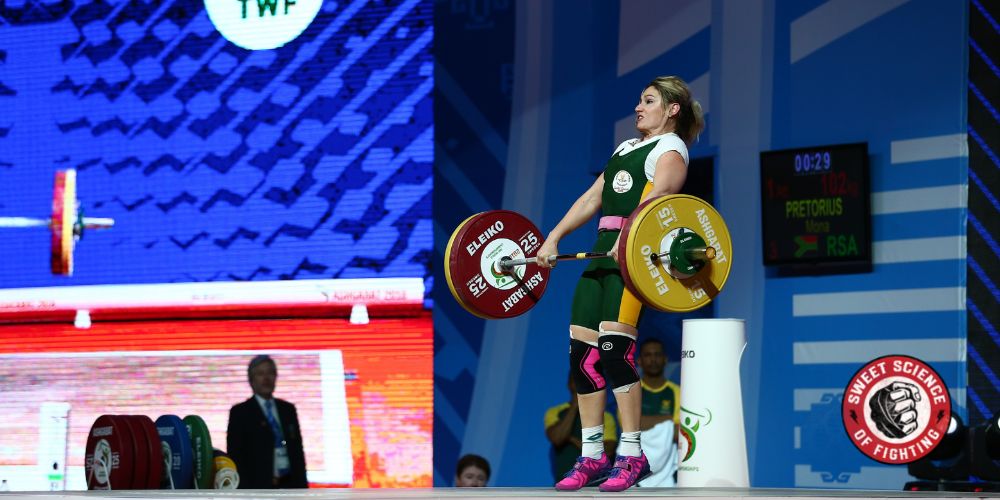In addition to well-developed aerobic and anaerobic capacities (link to my article), success in wrestling requires athletes to perform a broad range of grappling techniques with as much power as possible.
Simply stated, you can think of power as the ability of the body to produce the most significant amount of force in as little time as possible [1]. While velocity is the speed of an object in a specific direction, force can be described as strength or energy exerted [1].
Because power is force times velocity, if you want to improve your ability to produce power and improve wrestling performance, force and velocity need to be addressed in training. One method is using Olympic Weightlifting derivatives.
Practical Examples Of Power In Wrestling
If you decide to shoot a double leg takedown in competition, you want to drive through your opponent to finish the takedown with as much force and as fast as possible in a specific direction (i.e., velocity) so they cannot execute a counter move (e.g., sprawl, chest wrap).
In other words, you want to exert maximal power to perform the technique in competition successfully!
Having said that, when I think of the most dominant competitors in any combat sport, I think of Mike Tyson's devastating punches. Or Jordan Burroughs's lightning-fast double-leg takedowns. Or Wanderlia Silva's vicious knees to the head and Mirco Cro Cop's destructive head kicks.
These elite combat athletes performed their signature moves with a great deal of power, and that was an essential factor contributing to their success in competition at the highest level.
How Can You Become A More Powerful Wrestler?
Before I go into detail on maximizing your power production with Olympic lift derivatives, it is important to discuss the importance of developing your baseline strength with a well-designed wrestling strength program.
It is well established by research and practical experience that strength is a foundational element for power because stronger athletes can produce much greater power outputs [2].
5 Step Blueprint To Build A BJJ Strength Workout To Demolish Your Opposition
Learn how to plan your strength training to maximize transfer to the mats.
In other words, strength lays the foundation for power development. This is a critical concept you cannot overlook if you want to maximize your power outputs. Stronger athletes are faster athletes. It is that simple!
The importance of foundational strength for maximizing power outputs may be explained by the fact that stronger athletes can generate forces much faster than weaker athletes [2].
Research has demonstrated that stronger athletes generate much higher peak power production during the counter-movement jump and the squat jump than weaker athletes [3].
It is important to mention that for this study, the stronger athletes could squat more than twice their body weight. In comparison, the weaker athletes could only squat 1.2 times their body weight [3].
Once again, the formula for power is force times velocity, and the more force you can generate, the more power you can produce.
Important Examples With Elite Combat Athletes

Research has demonstrated that elite combat athletes have some important physical characteristics that separate them from non-elite combat athletes.
For example, in the sport of MMA, it has been observed that professional MMA fighters are more powerful compared to semi-pro and amateur MMA fighters [4].
In addition, it has been reported that professional MMA fighters are much stronger than semi-pro and amateur MMA fighters [4]. In wrestling, it has been observed that elite wrestlers can express greater power than amateur wrestlers [5].
Furthermore, elite wrestlers also have greater maximal strength than amateur wrestlers [5]. All of this makes sense because strength lays the foundation for power development.
But the fact that power is force times velocity illustrates the importance of improving your power production with a properly designed strength and conditioning program.
Once again, you can enhance power by increasing either force or power. Still, ideally, you want to improve both to enhance your force-velocity profile.
Optimal Methods For Improving Power

Research has demonstrated that Olympic weightlifting movements and their derivatives are more effective training methods to optimize strength-power adaptations than jump training, traditional weight training, and kettlebell training [6].
This may be due to the similarity between the second pull of the weightlifting movements and the coordinated triple extension of the hip, knee, and ankle (plantar flexion) joints [6].
This movement pattern is frequently performed during general sports tasks such as jumping, the acceleration phase of sprinting, change of direction, striking, kicking, throwing, and tackling [6].
It is well-established that traditional Olympic weightlifting is an extremely effective method for improving an athlete's power. They are highly technical and require countless hours of practice to develop the necessary skill to perform.
In contrast, Olympic weightlifting derivatives are a great alternative to traditional Olympic weightlifting movements because they are much easier to learn. They are less technical, and a greater injury rate is associated with traditional Olympic weightlifting, which may increase overuse injuries to the wrist and the shoulders [6].
This is because of the catching movement when turning the bar over to catch the weight in the receiving position.
Early research demonstrated that Olympic weightlifting derivatives provide a strength-power stimulus similar to traditional Olympic weightlifting techniques [6].
However, these studies had participants in the Olympic weightlifting and derivative group perform the lifts with an equal load, which is different from how Olympic lift derivatives should be programmed. Still, these early studies were critical for comparison reasons!
Recent studies used heavier loads for the Olympic weightlifting derivatives. They found they provided a more significant strength-power stimulus than traditional Olympic weightlifting techniques [7][8].
More recent studies show that the Olympic weightlifting derivatives provide a greater force or velocity stimulus because you use loads above your one repetition maximum (1-RM) for the power clean. Some exercises are also more ballistic (e.g., jump shrug and hang high pull) than traditional Olympic Weightlifting [6].
Anytime you see the word ballistic in the context of sports performance, it refers to an exercise that is performed with the intention to move with maximal velocity and to accelerate some object (e.g., barbell, medicine ball) with a mass throughout the entire movement [9].
Overall the previous research indicates that the Olympic weightlifting derivatives produce greater magnitude to peak force, rate of force development, velocity, and power than traditional Olympic weightlifting movements [7].
For whatever reason, some "keyboard scientists" on social media claim that you should avoid lifting weights because it will make you slow. If you are training incorrectly and moving heavy weights slowly all the time, that will likely happen.
In contrast, if you train correctly by logically organizing your training, you can maximize power (i.e., force times velocity), increasing your chances of success in competition.
This is why every world-class sports performance facility and university sports program worldwide has its athletes perform some form of weight training.
How To Program Olympic Weightlifting Derivatives

Although I prefer that amateur and professional fighters lift twice a week, some athletes feel they have to lift three times a week.
I know many athletes who performed power cleans three days a week during their days as collegiate athletes, and they feel like they are "missing out" if they are not lifting three days a week. The daily undulating periodization may be a good choice if you want to lift weights three days a week.
3 Days A Week Training
If you want to use the daily undulating periodization model, the first day would be focused on strength, the second day would be focused on power, and the third day would be focused on strength endurance.
If you look at the table below, you will see an overload programming chart from Suchomel et al. (2020). Weeks 1 through 3 are strength endurance-focused, weeks 4 to 8 are maximal strength-focused, and weeks 9 and 10 are power-focused.
Week | Set/Rep | Day 1 | Day 2 | Day 3 |
|---|---|---|---|---|
1 | 3 x 10 | 80% 10RM | 80% 10RM | 70% 10RM |
2 | 3 x 10 | 85% 10RM | 85% 10RM | 75% 10RM |
3 | 3 x 10 | 90% 10RM | 90% 10RM | 80% 10RM |
4 | 3 x 5 | 85% 5RM | 85% 5RM | 70% 5RM |
5 | 3 x 5 | 90% 5RM | 90% 5RM | 75% 5RM |
6 | 3 x 5 | 95% 5RM | 95% 5RM | 77.5% 5RM |
7 | 3 x 5 | 80% 5RM | 80% 5RM | 65% 5RM |
8 | 5 x 5 | 85% 5RM | 85% 5RM | 75% 5RM |
9 | 3 x 3 | 90% 3RM | 90% 3RM | 77.5% 3RM |
10 | 3 x 2 | 85% 2RM | 85% 2RM | 75% 2RM |
If you prefer block periodization, as illustrated in the loading chart, consider including some residual training. For example, when you're in the strength focused phase, you may want to include a single set of strength and endurance (10 repetitions) after you finish your sets.
You can use this same strategy if you lift weights twice a week. For example, if you're focused on maximum strength, you can do a speed strength set by using 40 to 55% of your one repetition maximum for the power clean to retain that motor ability at the end of your session.
As the old saying goes, "use it or lose it!" Issues regarding block periodization for team sports is why vertical integration has become a popular training method. This strategy works regardless of how many days a week you prefer to lift.
Most of the research has base programming Olympic lift derivatives on a percentage of the one repetition maximum for the power clean.
If you do not know what your one-repetition maximum is for the power clean, you should use the alternative methods listed below. If you are not sufficiently skilled for this particular movement, there is a risk of injury for trying to determine your one repetition maximum for the power clean.
I like the set-best repetition method because you can use it for the Olympic lift derivatives if you do not know your one-repetition maximum for the power clean. Also, you can use this method for accessory exercises (e.g., squat, bench press, barbell rows).
For this method, you determine your repetition maximum (3 repetitions, 5 repetitions, 10 repetitions). You may do the prescribed repetitions with anywhere from 70 to 100% intensity based on the maximum repetitions you performed in testing.
For example, if your 10-repetition maximum was 100 kg for a particular exercise, and you want to train at 80% intensity to develop strength endurance, you would perform 10 repetitions with 80 kg.
On the other hand, if you wanted to train at 90% intensity for strength endurance, you would perform 10 repetitions with 90 kg. The same rules apply for maximum strength and speed strength. This may be more practical for Olympic weightlifting derivatives that are force oriented.
As illustrated in the chart, you can use a percentage of your body weight or your back squat. This is for the Olympic lift derivatives that are more velocity oriented.
It is important that you notice that the percentages of body mass and percentages of the back squat are different for each exercise. This is because some exercises are more force-oriented, and others are more velocity oriented.
Olympic Weightlifting Derivative Program For Explosive Power
Week 1 Day 1
Exercise | Set/Rep | Load |
|---|---|---|
A1) Hang Clean Pull | 3 x 5 | 110% Power Clean 1RM |
B1) Front Squat | 3 x 5 | 80% 1RM |
C1) Lateral Lunge | 3 x 8/side | 7 RPE |
D1) Pull-Up | 3 x 8 | 7 RPE |
E1) DB Incline Bench Press | 3 x 8 | 7 RPE |
Week 1 Day 2
Exercise | Set/Rep | Load |
|---|---|---|
A1) Loaded Jump Squat | 4 x 1+1+1+1+1+1 | 30% Back Squat 1RM. Rest 20 sec between reps. |
B1) Drop Jumps | 1 x 10 | BW. 30 sec rest between reps. |
C1) Lateral Skater Jump | 3 x 4/side | BW |
D1) Medicine Ball Scoop Toss | 4 x 1+1+1+1+1+1 | 4-6 kg. 20 sec rest between reps. |
E1) Plyometric Push-Up | 4 x 8 | BW. 20 sec rest between reps. |
Week 1 Day 3
Exercise | Set/Rep | Load |
|---|---|---|
A1) Clean Pull | 3 x 5 | 75% Power Clean 1RM |
B1) Front Squat | 3 x 10 | 75% 1RM |
C1) Step Up | 3 x 10/side | 7 RPE |
D1) Inverted Row | 3 x 10 | 7 RPE |
E1) DB Overhead Press | 3 x 10 | 7 RPE |
Olympic Weightlifting Derivative Program & Course!
Get access to James Ramsey's Olympic Weightlifting derivative training program and course inside the SSoF Underground! But you get more than that. You can access to the private Discord community filled with world class combat sports coaches and PhD researchers.
Summary
Developing explosive power for wrestling is more than getting strong. You need to move heavy weights fast. Especially in a sport like wrestling where you need to manipulate other human beings. This is why Olympic Weightlifting derivatives are an effective power training modality for wrestlers.
References
1. Hori, N., Appleby, B., Andrews, W., & Nosaka, K. (2010). The effect of lifting straps on peak velocity, force, and power during clean pull.
2. Haff, G. G., & Nimphius, S. (2012). Training principles for power. Strength & Conditioning Journal, 34(6), 2-12.
3. Stone, M. H., O'BRYANT, H. S., McCoy, L., Coglianese, R., Lehmkuhl, M. A. R. K., & Schilling, B. (2003). Power and maximum strength relationships during performance of dynamic and static weighted jumps. The Journal of Strength & Conditioning Research, 17(1), 140-147.
4. James, L. P., Beckman, E. M., Kelly, V. G., & Haff, G. G. (2017). The neuromuscular qualities of higher-and lower-level mixed-martial-arts competitors. International journal of sports physiology and performance, 12(5), 612-620.
5. Chaabene, H., Negra, Y., Bouguezzi, R., Mkaouer, B., Franchini, E., Julio, U., & Hachana, Y. (2017). Physical and physiological attributes of wrestlers: an update. The Journal of Strength & Conditioning Research, 31(5), 1411-1442.
6. Suchomel, T. J., Comfort, P., & Stone, M. H. (2015). Weightlifting pulling derivatives: Rationale for implementation and application. Sports Medicine, 45(6), 823-839.
7. Suchomel, T. J., McKeever, S. M., & Comfort, P. (2020). Training with weightlifting derivatives: The effects of force and velocity overload stimuli. The Journal of Strength & Conditioning Research, 34(7), 1808-1818.
8. Suchomel, T. J., McKeever, S. M., Nolen, J. D., & Comfort, P. (2022). Muscle Architectural and Force-Velocity Curve Adaptations following 10 Weeks of Training with Weightlifting Catching and Pulling Derivatives. Journal of Sports Science and Medicine, 21(4), 504-516.
9. Maloney, S. J., Turner, A. N., & Fletcher, I. M. (2014). Ballistic exercise as a pre-activation stimulus: a review of the literature and practical applications. Sports medicine, 44(10), 1347-1359.

